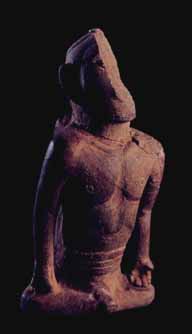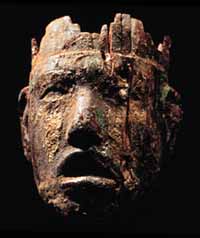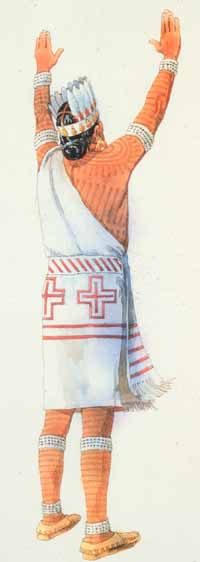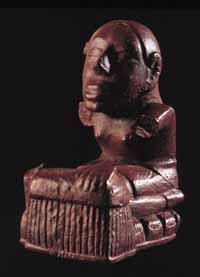
The Bridges Site in Marion County is an example of a Mississippian hamlet. The community consisted of several houses, some of which had been rebuilt. The community also included buildings archaeologists think were sweat lodges. A sweat lodge is a small, circular building where water was splashed on heated rocks to create steam. Sweat lodges continue to be used today by Native Americans. The Bridges Site also had a large rectangular public building.
 |
Figurine, Kincaid site, Massac County. | |
|
This sandstone figurine was found in one of the flat-topped platform mounds at the Kincaid site. |
||
The Kincaid site, described above under Settlement, was the center of Mississippian life in southern Illinois. Kincaid was home to members of many different families. While families had leaders to represent them, large Mississippian communities may have had political and spiritual leaders who spoke for the entire population. Leaders may have risen to authority and power by virtue of special talents or because they were born into an important family. Archaeologists believe these important leaders lived in buildings on the summit of the large flat-topped mounds.
 |
Emmons mask, Emmons site, Fulton County. | |
|
About nine hundred years ago, a Mississippian artisan carved a human face from a piece of red cedar, a tree still found along the bluffs of the central Illinois River valley and elsewhere in the state. The mask was once adorned with a sheet of copper, which may have covered the crown, but all that remains is a faint green stain of copper oxide. Both eyes are encircled with paint and below each eye two painted lines diverge from the eye onto each cheek. The paint was made by grinding lead ore-galena-into powder and mixing it with other materials. The "forked eye" is a common Mississippian symbol. It may represent the pattern of feathers around the eye of a peregrine falcon (falco peregrinus), but its meaning is not clear to archaeologists. |
||
Mississippian people created images of their leaders in a variety of materials, including wood. This mask is made of cedar and it may have been part of a rattle used in dances. Archaeologists have also found images of leaders engraved into marine shell, stone, and bone.
 |
Artist's illustration of Cahokia leader. |
One of the leaders at Cahokia, the most powerful Mississippian community in Illinois-if not all Mississippian society-was given special treatment when he died. He was placed on a blanket of several thousand shell beads. Nearby, archaeologists found more than 1,100 arrow points. They also found numerous discoidals, wheel-shaped stones used in a game.
 |
Keller figurine, BBB Motor site, Madison County. | |
|
Here we see a female kneeling on a series of rectangles, some of which have vertical lines. Her outstretched left hand, and though missing, probably her right hand also, rest on a rectangular object. Some archaeologists think this woman is using a mano and metate to grind plant food such as corn. |
||
|
|
Copyright © 2000 Illinois State Museum